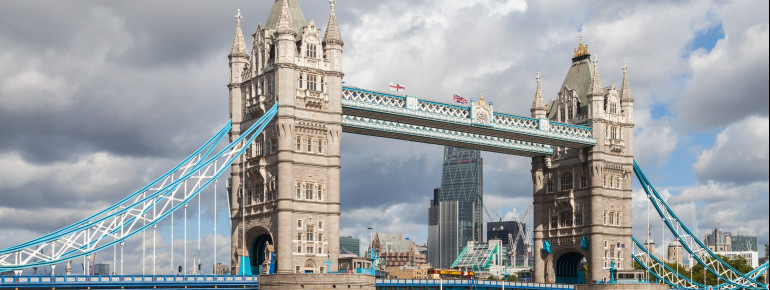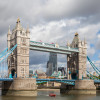Contents
Description
The Tower Bridge Exhibition in the Bridge Towers
The most distinctive feature of Tower Bridge is undoubtedly the two neo-Gothic bridge towers, which are connected by a pedestrian walkway 33 meters above the opening bridge sections. A view from the pedestrian walkway over London city represents the highlight of a visit, especially since 2014 when the pedestrian bridge was equipped with a glass floor, thus enabling a view over 40 meters into the depths.
Additionally, the towers house the Tower Bridge Exhibition, an exhibition about the construction and maintenance of the bridge. This museum contains films and photographs about the construction phase as well as objects that were used during its erection. The old engine room, which was necessary for operating the opening mechanism at the time, is also open to visitors.
Historical Information
As early as the 1850s, initial plans for the construction of a bridge east of London Bridge were submitted. Especially from the late eighties onwards, crossing the Thames became increasingly problematic, as more than a third of the city's population lived east of London Bridge, thus overloading it.
In 1870, the Tower Subway was then erected, a tube beneath the Thames that was briefly used as a subway tunnel and is now only used as a pedestrian tunnel. However, this could not solve the traffic problems.
Subsequently, a committee was founded in 1876 with the task of definitively getting the traffic problems under control. The design by Horace Jones, the City of London's master builder, who was himself a member of the committee, was finally approved in 1884. The foundation stone was laid on June 21, 1886, with a total of five construction companies and 432 construction workers employed over a construction period of eight years in the erection of Tower Bridge.
The hard figures prove the construction of a gigantic structure for the standards of that time. The pillars that were sunk into the river to support the bridge have a total weight of 70,000 tons. The bridge itself consists of over 27,000 tons of bricks, with the two opening bridge sections alone each weighing 1,200 tons. The basic framework of the bridge was erected with bricks and steel and then clad with Portland limestone and granite, on the one hand to create a more pleasing exterior and on the other hand to form a visual unit with the Tower of London located on the northern shore.
The opening on June 30, 1894, by Edward VII, then Prince of Wales and later King of the British Empire, and his wife Alexandra of Denmark, could not be witnessed by architect Horace Jones, as he died in 1887.
Interesting facts
- Tower Bridge London is the the best rated tourist attraction in Great Britain and Northern Ireland.
- The day pass at Tower Bridge London is £16 making it one of the 3 cheapest tourist Attractions in Great Britain and Northern Ireland.
How to get there
The Tower Bridge is located somewhat east of London's city center.
By Car:
Those who want to drive across the bridge should follow the A 100, as it runs over Tower Bridge.
By Public Transport:
Tower Bridge is very well accessible by London Tube. The Circle Line as well as the District Line stop at Tower Hill station, which is located directly on the northern shore of the bridge.




